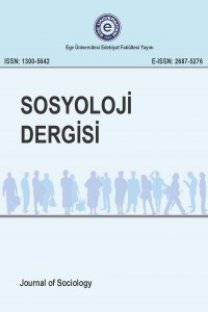Fae Myenne Ng'in Bone (Kemik) Adlı Romanında Çinli Amerikan Kimliğinin Temsili
Çağdaş Çinli Amerikalı yazının ilgiyle üzerinde durduğu konulardan biri de Çinli Amerikalı kimlik inşasıdır. Fae Myenne Ng’in Bone (Kemik) adlı romanı da belli başlı temalar ve metaforlar aracılığı ile kimlik inşası konusuna katkıda bulunmaktadır. Kimlik oluşturma sürecinin nasıl tartışıldığını örneklendirmek üzere, bu makalenin teorik alt yapısı Werner Sollors tarafından ortaya konan “rıza” ve “soy” kavramları üzerine dayandırılacaktır. Teorik kavramların tanımlarının açıklanmasından sonra, “kâğıt kimlikler”, “rıza” ve “soy” kavramlarının hem kimlik hem de aile oluşumuna katkıları ve son olarak “kemik” metaforunun Çinli Amerikalı kimlik inşasına nasıl katkı sağladıklarını irdelemektedir.
REPRESENTATION OF CHINESE AMERICAN IDENTITY IN FAE MYENNE NG’S BONE
One of the major concerns of contemporary Chinese American fiction is to conceive the construction of Chinese American identity. Fae Myenne Ng’s novel titled Bone contributes to the discussion of identity construction through major themes and metaphors. To illustrate the metaphors that are repeatedly used in the novel, in terms of identity construction, this article structures its theoretical framework on the concepts of “consent” and “descent” that were put forward by Werner Sollors. After the clarification of these theoretical concepts regarding their definitions, it will also be exemplified through different examples of how “paper identities”, the importance of “consent” and “descent” in family and identity formation, and lastly the significance of the “bone” metaphor in the novel contributes to the representation of Chinese American identity.
Keywords:
identity, consent, descent, family, immigration,
___
- Chang, I. (2003). The Chinese in America: A Narrative History. New York: Penguin Books.
- Gee, Allen. (2004) “Deconstructing a Narrative Hierarchy: Leila Leong’s “I” in Fae Myenne Ng’s Bone” MELUS. Vol. 29. No. 2. Elusive Illusions: Art and Reality. Pp. 129-140. Published by MELUS
- Jefferson, T. (1776). The Declaration of Independence. In D. Hollinger and C. Capper (Eds.). The American Intellectual Tradition: A Sourcebook. Volume I: 1630-1865. (p. 129). London: Oxford University Press.
- Kallen, H. (1996). Democracy Versus the Melting Pot: A Study of American Nationality. In W. Sollors (Ed.). Theories of Ethnicity: A Classical Reader. (pp.67-92). Washington Square, New York: New York University Press.
- Kim, Thomas W. (1999). “ ‘For a Paper Son, Paper is Blood’: Subjectivation and Authenticity in Fae Myenne Ng’s Bone” MELUS. Vol. 24. No.4. Asian American Literature. Pp. 41-56. Published by MELUS
- LeBlanc, Diane C. (2000). “Neologism as Oppositional Language in Fae Myenne Ng's Bone”. Rocky Mountain Review of Language and Literature. Vol. 54, No. 1 Pp. 11-22. Published by Rocky Mountain Modern Language Association.
- Ng, Fae Myenne. (1993). Bone: A Novel. New York: Harper Perennial.
- Shaw, Angel Velasco. (1993) BOMB, Spring, 1993. No:43 pp.8-9. Published by New Art Publications. Stable URL: https://www.jstor.org/stable/40424584
- Sollors, W. (1986). Beyond Ethnicity: Consent and Descent in American Culture. New York: Oxford University Press.
- Szmańko, K. (2018). Reminiscing in white in Fae Myenne Ng's Bone. Brno studies in English, 44. P.133-143
- ISSN: 1300-5642
- Yayın Aralığı: Yılda 2 Sayı
- Başlangıç: 1987
- Yayıncı: Ege Üniversitesi, Edebiyat Fakültesi
Sayıdaki Diğer Makaleler
Sibel ERDOĞAN, Bilge Deniz ÇATAK AŞKAR
İZMİR’DEKİ İSTANBULLU YAŞAM TARZI GÖÇMENLERİNİN “İZMİR İMAJI”
KENTSEL DÖNÜŞÜM PROJE ALANLARINDA KENTSEL DÖNÜŞÜM ALGISI: BALLIKUYU ÖRNEĞİ
YAŞLILIK VE SUÇ İLİŞKİSİ ÜZERİNE BİR DEĞERLENDİRME
Fae Myenne Ng'in Bone (Kemik) Adlı Romanında Çinli Amerikan Kimliğinin Temsili
